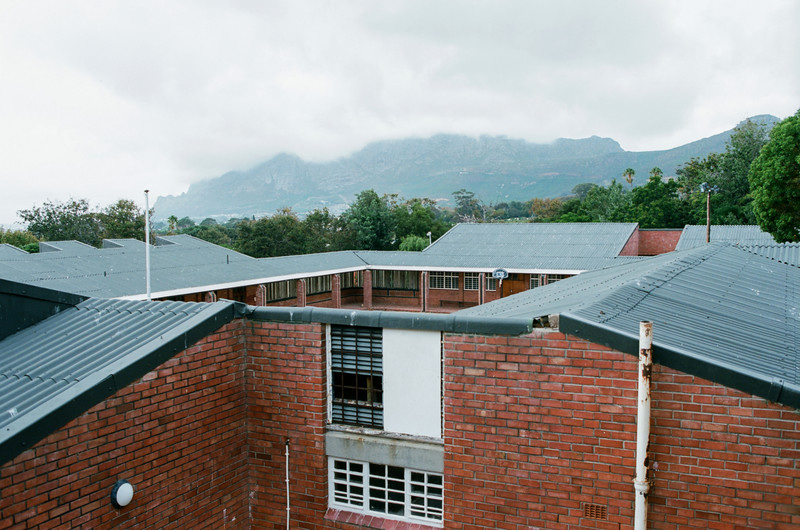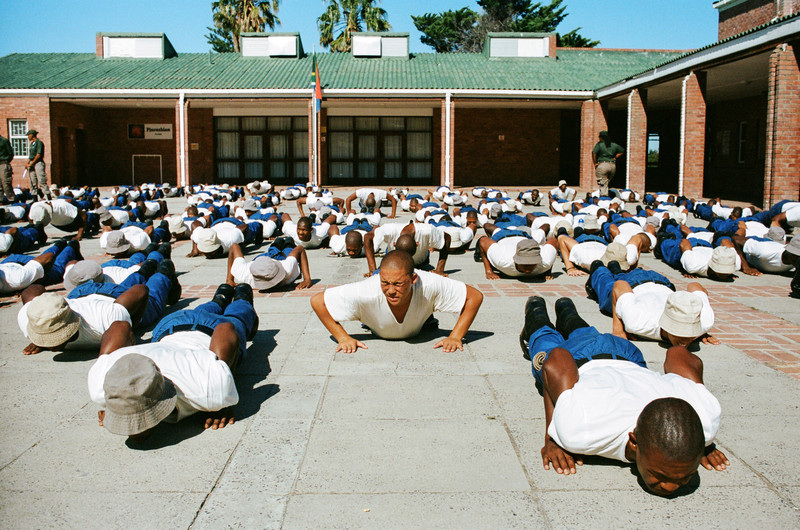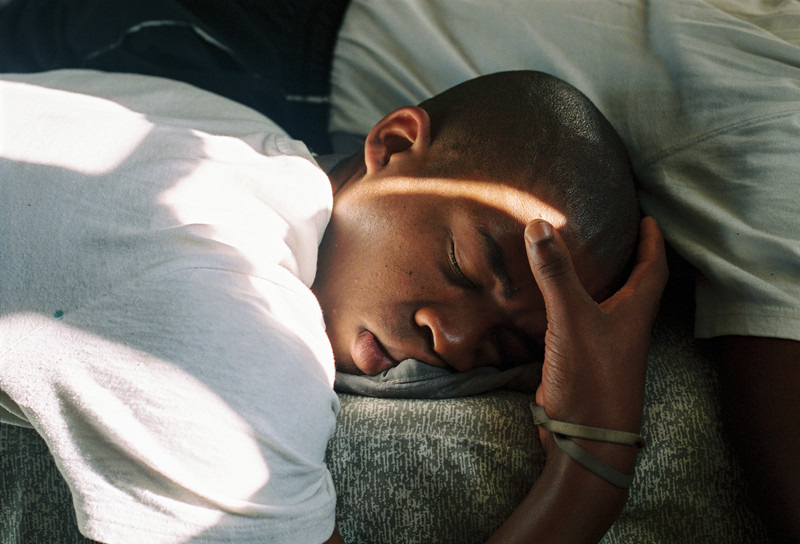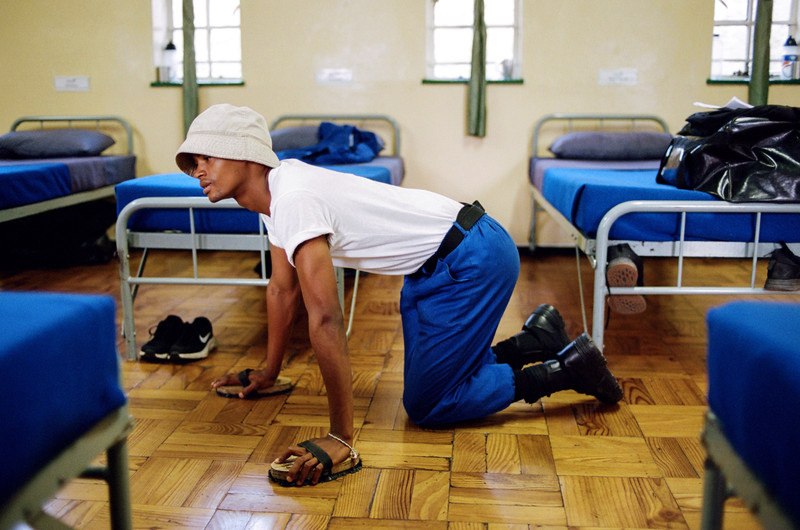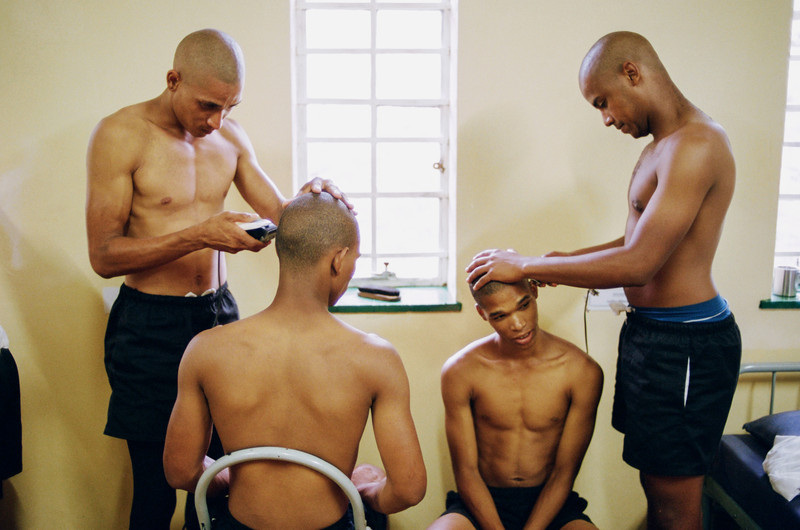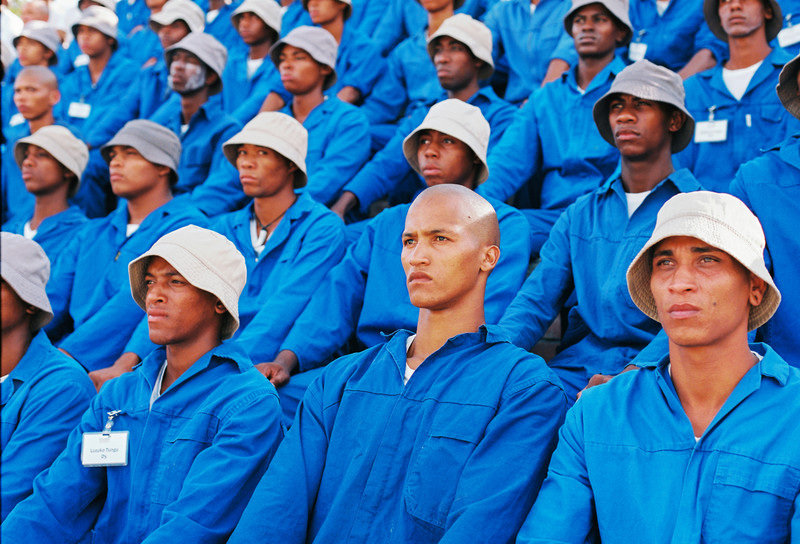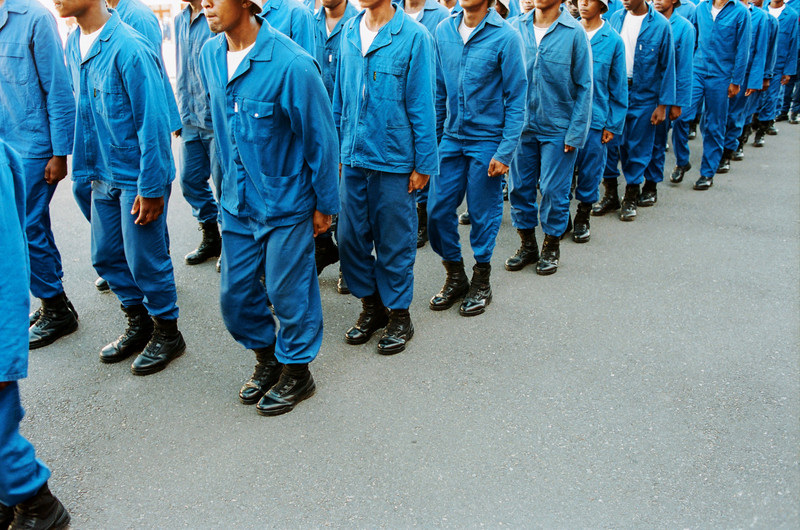Chrysalis Academy
© Alessandro IovinoA visual journey of masculinity transformation in Cape Town.
Foreword by Agnese Roda
"I came to a point in my life where I felt out of place and even though my life was heading in a certain direction,to me it felt I had no direction at all. I always knew that Chrysalis Academy was all about personal development, but I first had to find out whether or not I stood a chance of getting in. To my luck and advantage I was accepted and today while I'm writing this, I am sitting inmydormroom, a few weeks away from graduation and in a better space than when I started this 3 month journey."
- A 19Charlie graduate
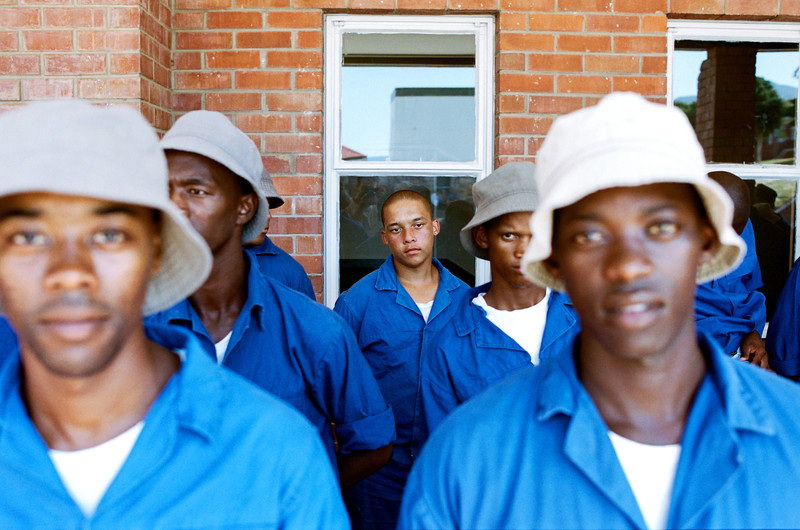

In early 2020, photographer Alessandro Iovino documented the life of a group of young men living and studying at Chrysalis Academy, a youth development centre in Cape Town, South Africa. The project portrays the educational environment and path of young men, aged 18 to 25, from impoverished communities, where inequality and general violence confront them daily. They enrolled voluntarily in a transformative journey to separate from their current life of struggle and change it into a potential. Iovino’s work captures a glimpse of their transformation, while interrogating what it means to become a new man in contemporary South Africa, a society with stratospheric levels of gender-based violence, other violent crimes and corruption, often operated by men at different levels.
The Chrysalis Academy practices holistic youth development, which distinguishes itself from traditional forms of correctional and educational approaches. Rather, the Academy’s intention is to focus on repurposing lives, by providing resilience tools, through mental, physical and spiritual development work. “Chrysalis'' captures the 2020 students attending the 19Charlie’s class, a name inspired by the international radio alphabet (because of its extensive use in military communications). Inside the academy though, the military discipline is intended as a mental and physical framework to support an internal, holistic work on emotions and vulnerability, where sensitivity is synonymous with strength. And its expression is the catalyst for unleashing the potential for good.
These teenagers come mainly from townships, community housing projects (flats), and rural areas. Township and community flats were built during apartheid times (1948 until the early 1990s) where a legal system of institutionalized division and white supremacy was developed with the sole purpose of classifying and separating people on the basis of race. It entrenched the economic and social rule by whites, relegating other South Africans (black, colored and Asians in Apartheid parlance) to lower socio-economic categories. The physical separation is no longer legally present, but lives on to this day. The vast majority of black South Africans in Cape Town live in underdeveloped, functionally segregated parts of the city, which are essentially disconnected from the surroundings, and are dominated by informal settlements or brutally minimal, utilitarian built environments. Infrastructure and transport obstacles work to ensure that those people from rural areas remain isolated, and unable to participate in “city” life. These areas are usually dominated by high levels of crime, violence, extreme levels of unemployment (and under-employment), low levels of education amongst residents, and inadequate transport and infrastructure.
Chrysalis Academy is situated in Tokai, on the slopes of Table Mountain, the iconic massif which extends from the Cape Town city centre, right through to the southernmost tip of the Cape Peninsula. The school was repurposed some twenty years ago from a state-run reformatory. The premises borders Pollsmoor Prison, to where Nelson Mandela was incarcerated after being transferred from Robben Island Prison. Nowadays Pollsmoor is an epicenter of gang activities which dominate violent crime in the Western Cape. Despite the buildings’ structure and outward appearances of a reformatory, Chrysalis Academy creates contrasts with the surroundings through the interior spaces. Buildings are named after flowers, where the reality of danger is changed into magic. It is a haven, a safe space, offering discipline, community, survival tools and healthier options to the men who live there. Even at first glance, this place has something different. It is transformative. The aesthetic of a reformatory is made beautiful.
Students at Chrysalis Academy are fathers, brothers, cousins, partners and much more, with all the nuances and implications that being a man in South Africa brings. A commonality is that their lives are filled with struggle, and they are intoxicated with ideas of masculinity which do not serve them well, and from which they wish to separate. South Africa is a country with deeply entrenched and problematic male attitudes and behaviors, such as violence as an acceptable tool to resolve conflicts, abuse of women and children, substance abuse, and risky sexual behaviors. Men are frequently portrayed as abusers, yet they too are victims of the racial and gendered order of society they live in. This duality of victim and perpetrator is large in the communities of black and colored men, who have lower education levels than their white counterparts, who live in places steeped in a multitude of violences, where formal, dignified employment is a rarity and opportunities for progress are better in crime than most other avenues. Chrysalis Academy attempts to intervene in this domain, helping young men change their attitudes and behaviors, renegotiating their social position and identity and “challenge ideas of hegemonic masculinity” (Morrell, 2012).
Studies on masculinity come out of the research of Prof Raewyn Connell, who coined the term hegemonic masculinity as part of a theoretical framework developed to analyse men’s power and their subordination of others (including other men). Connell proposed a multiplicity of masculinities and hierarchies of power, showing how men exercise it (Carrigan, Connell & Lee, 1985). The concept has been developed in the South African context by Prof Rob Morrell, who used context-specific classifications to analyze the country’s high levels of violence and the gender relationships under colonialism, apartheid and post-apartheid. According to Morrell (2012), there are three type of South African masculinity: a ‘‘white’’ masculinity (represented in the political and economic dominance of the white ruling class); an ‘‘African,’’ rurally based masculinity that resided in and was perpetuated through indigenous institutions (such as chiefship, communal land tenure, and customary law) and finally a ‘‘black’’ masculinity that had emerged in the context of urbanization and the development of geographically separate and culturally distinct African townships (Morrell, Jewkes & Lindegger: 2012).
Among the reasons that the concept of ‘hegemonic masculinity’ has become widely used in gender research in South Africa is because it allows the multiple and unequal location of men themselves, fluidity in power relations and the persistence of patriarchal trends. Connell (1987, 1995) says that “hegemony is likely to be established only if there is some correspondence between cultural ideal and institutional power, collective if not individual’ (1995: 77) and that ‘“hegemonic masculinity” is always constructed in relation to various subordinated masculinities as well as in relation to women’ (Connell 1987: 183). Hegemony in fact becomes social power, evident in “the ability to impose a definition of the situation, to set the terms in which events are understood and issues discussed, to formulate ideals and define morality’ (Connell 1987: 107). Du Pisani (2001) informs that during the years of apartheid, the white authoritarian style of ruling the country created a set of political and social processes that emphasised supremacy of one type of man, as well as alliances that perpetuated hegemony. Unterhalter (2000) highlights that starting with Nelson Mandela and the advent of democratic elections in 1994, despite him being part of an elite (lawyer, member of the royal family), Mandela promoted an “heroic” and more egalitarian type of masculinity, where men are able to cook and care for children. “His public representation challenged much of the violent and authoritarian behaviors and attitudes associated with apartheid’s white male politicians, with some elements within the liberation movement and also within the traditional, patriarchal African masculinities of Bantustan leaders” (Unterhalter 2000).
It is with this background of ideals of strength and dominance that young men at Chrysalis Academy struggle with and seek help to change. The Academy’s principal is a woman, Ms Lucille, who always had a dream of better South Africa and chose Chrysalis as a symbolic name for this transformative choice. She brings to the school a curriculum of holistic stempoint, to alternate to the military physical training and mindset. The curriculum involves yoga, and T.R.E, an innovative tension and stress-release therapy that works efficiently to ease the trauma of these young men’s lives. Once enrolled, the young men commit to a policy of total focus, to be part of a different educational path where they are offered space, time and tools to shift their lives from toxic masculinity into new men who can live a full life, respecting themselves, knowing their values and making positive impacts in society after they emerge from Chrysalis.
Inside the academy, they are only allowed visitors twice in their three-months stay. Television, radio and other media are also cut during this time of isolation and incubation.
Discipline and willpower are key elements to the training. Everyday before their lessons, they are required to follow a strict routine, starting with physical training at 4:30 am. The morning regimen echoes the stark life of military training, with bedroom inspections, meticulously folded clothing and a healthy breakfast eaten in silence. From 9 am until 3 pm, the students engage in skills learning, where they are given choices to foster innate interests. Skills offered at the academy are varied and include trades (e.g. welding), life skills (e.g. cooking), social tools (e.g. “peace training”), and confidence-building (e.g. survival in wilderness). By dinnertime (8.30 pm) they arrive exhausted, but still huddled together, singing, dancing and smiling.
The educational process is about establishing rules of engagement, but also developing dedication and a real commitment to completing tasks, by allowing them to ask themselves what and how they really want to change their lives. Each person’s answer becomes central to their development. The three-month course aims to identify and then grow individuals’ latent abilities and to then teach them how to use their skills effectively, facilitating their ability to fulfil new roles in society. In so doing, the Academy prepares them for securing and retaining a job, and to live a life worthy of their talents.
During the training, many students discover extraordinary and previously untapped abilities. But fundamental to their growth, and a remarkable, innate feature of their time at the Academy, is their diligence and devotion to self-improvement. It seems that once they connect to their abilities and talents, the positive changes become unstoppable. The personal development becomes a rite of passage, which brings them to a more egalitarian way of being men in this world, starting with the realization of the power within themselves. The gratitude they show for being part of the project is palpable.
As the Academy grows, more graduate students become involved in teaching, creating a new “masculine legacy” of 20 years. After the training, students are offered a twelve-month, paid work placement. This is a significant inflection point in many journeys. Support continues after placement in jobs, extending to a 5-year program of mutual support and community reintegration. The boys of 19Charlie were set to graduate just as South Africa entered lockdown in response to the Covid-19 pandemic. What happens next remains to be seen.
Iovino’s photographic work depicts the isolation moments of the students, inside the academy and out of the troubles of the city of Cape Town. The city remains one of the most divided cities in South Africa, where the marginalised are the majority, and where the possibility of becoming a victim of crime or violence is ever present. Iovino, who identifies as male, takes the audience on an “insider’s journey”, connecting to a historical moment of shifting awareness. As he explains, “Men today need to change, because we never had to do it before. Men need to reconsider privilege and positions of entitlement, as up until now, only women have transformed. Instead we need men to participate in this opportunity too.”
click to view the complete set of images in the archive
